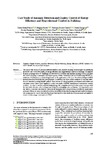Case Study of Anomaly Detection and Quality Control of Energy Efficiency and Hygrothermal Comfort in Buildings

Use este enlace para citar
http://hdl.handle.net/2183/26709Coleccións
- Investigación (FIC) [1728]
Metadatos
Mostrar o rexistro completo do ítemTítulo
Case Study of Anomaly Detection and Quality Control of Energy Efficiency and Hygrothermal Comfort in BuildingsTítulo(s) alternativo(s)
Proceedings of the 8th International Conference on Data Science, Technology and Applications (DATA 2019)Autor(es)
Data
2019Cita bibliográfica
Eiras-Franco, C., Flores, M., Bolón-Canedo, V., Zaragoza, S., Fernández-Casal, R., Naya, S., & Tarrío-Saavedra, J. (2019). Case Study of Anomaly Detection and Quality Control of Energy Efficiency and Hygrothermal Comfort in Buildings. In DATA (pp. 145-151).
Resumo
[Abstract] The aim of this work is to propose different statistical and machine learning methodologies for identifying
anomalies and control the quality of energy efficiency and hygrothermal comfort in buildings. Companies
focused on energy sector for buildings are interested on statistical and machine learning tools to automate
the control of energy consumption and ensure quality of Heat Ventilation and Air Conditioning (HVAC) installations.
Consequently, a methodology based on the application of the Local Correlation Integral (LOCI)
anomaly detection technique has been proposed. In addition, the most critical variables for anomaly detection
are identified by using ReliefF method. Once vectors of critical variables are obtained, multivariate and
univariate control charts can be applied to control the quality of HVAC installations (consumption, thermal
comfort). In order to test the proposed methodology, the companies involved in this project have provided
the case study of a store of a clothing brand located in a shopping center in Panama. It is important to note
that this is a controlled case study for which all the anomalies have been previously identified by maintenance
personnel. Moreover, as an alternatively solution, in addition to machine learning and multivariate techniques,
new nonparametric control charts for functional data based on data depth have been proposed and applied to
curves of daily energy consumption in HVAC.
Palabras chave
Statistical Quality Control
Anomaly detection
Feature selection
Energy efficiency
HVAC
Industry 4.0
LOCI
ReliefF
Functional data analysis
Anomaly detection
Feature selection
Energy efficiency
HVAC
Industry 4.0
LOCI
ReliefF
Functional data analysis
Versión do editor
ISBN
978-989-758-377-3





